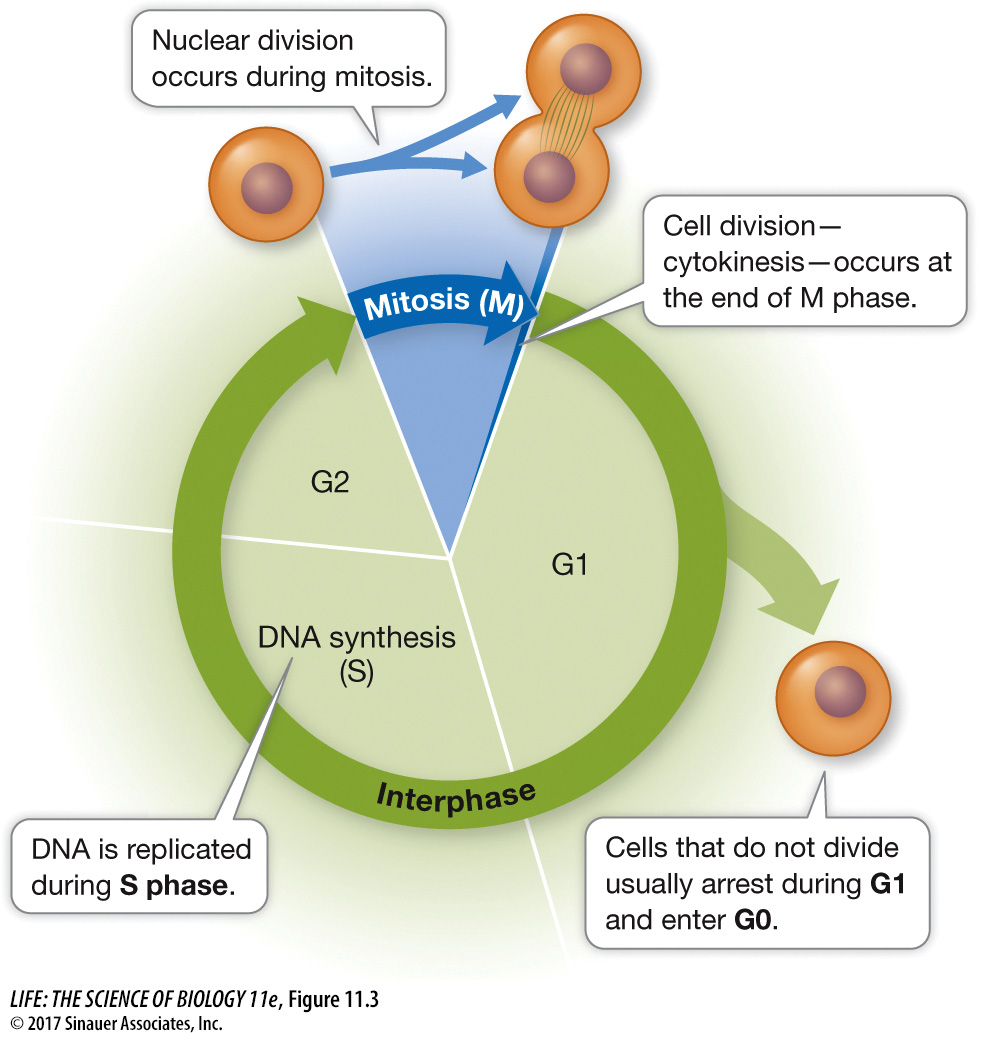key concept
11.2
The Eukaryotic Cell Division Cycle Is Regulated
key concept
11.2
The Eukaryotic Cell Division Cycle Is Regulated
As you will see throughout this book, different cells have different rates of cell division. Some cells, such as those in an early embryo, divide rapidly and continuously. Others, such as neurons in the brain, don’t divide at all. This suggests that the signaling pathways for cells to divide are highly controlled.
focus your learning
Dividing eukaryotic cells undergo an orderly sequence of events that together make up the cell cycle.
Events of the eukaryotic cell cycle are internally regulated.
External factors stimulate eukaryotic cells in the G0 state to begin dividing.
In eukaryotes, the period from one cell division to the next is known as the cell cycle. The cell cycle can be divided into mitosis/cytokinesis and interphase. During interphase, the cell nucleus is visible and typical cell functions occur, including DNA replication. Interphase begins when cytokinesis is completed and ends when mitosis (M) begins (Focus: Key Figure 11.3). In this section we will describe the events of interphase, especially those that trigger mitosis.
focus: key figure

Q: If the DNA content of a human skin cell at the beginning of mitosis is 12 picograms (1 pg = 10–12 g), what is the DNA content of a cell in G1?
6 pg
The duration of the cell cycle varies considerably in different cell types. In the early embryo the cell cycle may be as short as 30 minutes, whereas rapidly dividing cells in an adult human typically complete the cycle in about 24 hours. In general, cells spend most of their time in interphase. So if we take a snapshot through the microscope of a cell population, only a few cells will be in mitosis or cytokinesis at any given moment. Interphase has three subphases called G1, S, and G2. In a cell cycle of 24 hours, these subphases would typically last for 11 hours (G1), 8 hours (S), and 4 hours (G2), with the remaining 1 hour spent in mitosis.
G1 phase. During G1 phase, each chromosome is a single, unreplicated DNA molecule with associated proteins. Variations in the duration of G1 account for most of the variability in the length of the cell cycle in different cell types. Some rapidly dividing embryonic cells dispense with it entirely, whereas other cells may remain in G1 for weeks or even years.
The G1-
to- At the G1-S transition. to- the commitment is made to DNA replication and subsequent cell division.S transition S phase. DNA replication occurs during S phase (see Key Concept 13.3 for a detailed description of DNA replication). Each chromosome is duplicated and thereafter consists of two sister chromatids (the products of DNA replication). The sister chromatids remain joined together until mitosis, when they segregate into two daughter cells.
G2 phase. During G2 phase, the cell makes preparations for mitosis—
for example, by synthesizing and assembling the structures that move the chromatids to opposite ends of the dividing cell.
The initiation, termination, and operations of these phases are regulated by specific signals. Not all cells follow this “march through the phases.” Some cells in G1 enter an inactive resting phase of the cell cycle called G0. These cells sometimes return to G1 and the rest of the cell cycle under certain environmental conditions, such as an extracellular signal. Otherwise, cells may stay in G0; examples in humans are cells of the heart (cardiac muscle) and brain (neurons).